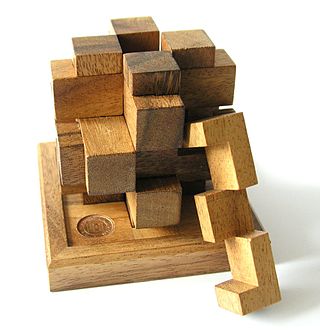
The Rubik's Cube is a 3-D combination puzzle originally invented in 1974 by Hungarian sculptor and professor of architecture Ernő Rubik. Originally called the Magic Cube, the puzzle was licensed by Rubik to be sold by Pentangle Puzzles in the UK in 1978, and then by Ideal Toy Corp in 1980 via businessman Tibor Laczi and Seven Towns founder Tom Kremer. The cube was released internationally in 1980 and became one of the most recognized icons in popular culture. It won the 1980 German Game of the Year special award for Best Puzzle. As of March 2021, over 450 million cubes had been sold worldwide, making it the world's bestselling puzzle game and bestselling toy. The Rubik's Cube was inducted into the US National Toy Hall of Fame in 2014.
A puzzle is a game, problem, or toy that tests a person's ingenuity or knowledge. In a puzzle, the solver is expected to put pieces together in a logical way, in order to arrive at the correct or fun solution of the puzzle. There are different genres of puzzles, such as crossword puzzles, word-search puzzles, number puzzles, relational puzzles, and logic puzzles. The academic study of puzzles is called enigmatology.

A toy or plaything is an object that is used primarily to provide entertainment. Simple examples include toy blocks, board games, and dolls. Toys are often designed for use by children, although many are designed specifically for adults and pets. Toys can provide utilitarian benefits, including physical exercise, cultural awareness, or academic education. Additionally, utilitarian objects, especially those which are no longer needed for their original purpose, can be used as toys. Examples include children building a fort with empty cereal boxes and tissue paper spools, or a toddler playing with a broken TV remote control. The term "toy" can also be used to refer to utilitarian objects purchased for enjoyment rather than need, or for expensive necessities for which a large fraction of the cost represents its ability to provide enjoyment to the owner, such as luxury cars, high-end motorcycles, gaming computers, and flagship smartphones.

A mechanical puzzle is a puzzle presented as a set of mechanically interlinked pieces in which the solution is to manipulate the whole object or parts of it. While puzzles of this type have been in use by humanity as early as the 3rd century BC, one of the most well-known mechanical puzzles of modern day is the Rubik's Cube, invented by the Hungarian architect Ernő Rubik in 1974. The puzzles are typically designed for a single player, where the goal is for the player to see through the principle of the object, rather than accidentally coming up with the right solution through trial and error. With this in mind, they are often used as an intelligence test or in problem solving training.

Rubik's Magic, like the Rubik's Cube, is a mechanical puzzle invented by Ernő Rubik and first manufactured by Matchbox in the mid-1980s.

An egg of Columbus or Columbus's egg refers to a brilliant idea or discovery that seems simple or easy after the fact. The expression refers to an apocryphal story, dating from at least the 16th century, in which it is said that Christopher Columbus, having been told that finding a new trade route was inevitable and no great accomplishment, challenges his critics to make an egg stand on its tip. After his challengers give up, Columbus does it himself by tapping the egg on the table to flatten its tip.

A bascule bridge is a moveable bridge with a counterweight that continuously balances a span, or leaf, throughout its upward swing to provide clearance for boat traffic. It may be single- or double-leafed.

Think Fast is an American children's game show which aired on Nickelodeon from May 1, 1989, to March 30, 1990, with reruns airing weekly until June 29, 1991.
The Eggerland (エッガーランド) series consists of several puzzle games developed by HAL Laboratory. Its first release was in 1985 for MSX computer systems. The gameplay is almost exactly the same across the series, with only a few changes over the years, mainly graphical.

A rattleback is a semi-ellipsoidal top which will rotate on its axis in a preferred direction. If spun in the opposite direction, it becomes unstable, "rattles" to a stop and reverses its spin to the preferred direction.

Perfection is a game originally produced by the Pennsylvania company Reed Toys and then by the Milton Bradley company. The object is to put all the pieces into matching holes on the board before the time limit runs out. When time runs out, the board springs up, causing many, if not all, of the pieces to fly out. In the most common version, there are 25 pieces to be placed into a 5×5 grid within 60 seconds.
Child development stages are the theoretical milestones of child development, some of which are asserted in nativist theories. This article discusses the most widely accepted developmental stages in children. There exists a wide variation in terms of what is considered "normal", caused by variations in genetic, cognitive, physical, family, cultural, nutritional, educational, and environmental factors. Many children reach some or most of these milestones at different times from the norm.

A mechanical watch is a watch that uses a clockwork mechanism to measure the passage of time, as opposed to quartz watches which function using the vibration modes of a piezoelectric quartz tuning fork, or radio watches, which are quartz watches synchronized to an atomic clock via radio waves. A mechanical watch is driven by a mainspring which must be wound either periodically by hand or via a self-winding mechanism. Its force is transmitted through a series of gears to power the balance wheel, a weighted wheel which oscillates back and forth at a constant rate. A device called an escapement releases the watch's wheels to move forward a small amount with each swing of the balance wheel, moving the watch's hands forward at a constant rate. The escapement is what makes the 'ticking' sound which is heard in an operating mechanical watch. Mechanical watches evolved in Europe in the 17th century from spring powered clocks, which appeared in the 15th century.

In geometry, a superegg is a solid of revolution obtained by rotating an elongated superellipse with exponent greater than 2 around its longest axis. It is a special case of superellipsoid.

Columbus Breaking the Egg is a 1752 engraving by English artist William Hogarth. Issued as the subscription ticket for his treatise on art, The Analysis of Beauty, it depicts an apocryphal tale concerning Christopher Columbus's response to detractors of his discovery of the New World. Hogarth uses the story as a parallel to what he considered his own discoveries in art.

Tesla's Egg of Columbus was a device exhibited in the Westinghouse Electric display at the 1893 Chicago World's Columbian Exposition to explain the rotating magnetic field that drove the new alternating current induction motors designed by inventor Nikola Tesla by using that magnetic field to spin a copper egg on end.

The Egg of Columbus is a dissection puzzle consisting of a flat egg-like shape divided into 9 or 10 pieces by straight cuts. The goal of the puzzle is to rearrange the pieces to form other specific shapes, such as animals.

Egg balancing is a traditional Chinese practice of standing eggs on their ends that has also been popularized in the United States. Although the irregular shape of eggs makes this somewhat difficult, eggshells typically have many imperfections such that the vast majority can be balanced on their broad ends with minimal effort.
A flatbed trolley a common form of freight transport in distribution environments, for moving bulk loads. Trolleys can aid in reducing effort required to move a load by allowing the user to pull or push instead of lift and carry. A very simple design offers a basic flat platform with four casters and a fixed handle which is used to either push or pull the platform with the load on the platform. Without a flat surface it becomes an open frame trolley and without a handle it is a bogie or dolly.














